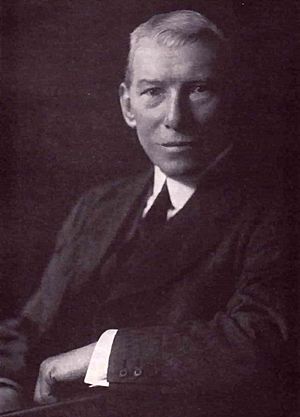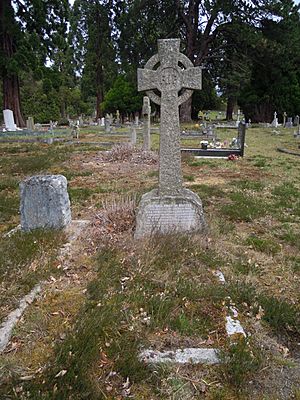Michael O'Dwyer facts for kids
Quick facts for kids
Sir
Michael O'Dwyer
|
|
|---|---|
 |
|
| Lieutenant Governor of the Punjab | |
| In office 26 May 1913 – 26 May 1919 |
|
| Personal details | |
| Born | 28 April 1864 Barronstown, Limerick Junction, County Tipperary, Ireland |
| Died | 13 March 1940 (aged 75) Caxton Hall, Westminster, London, England |
| Cause of death | Assassination (gunshot wound) |
| Resting place | Brookwood Cemetery |
| Spouse | Una Eunice Bord |
| Children | 2 |
| Alma mater | Balliol College, Oxford |
| Occupation | Colonial Administrator |
| Known for |
|
Sir Michael Francis O'Dwyer (born 28 April 1864 – died 13 March 1940) was an Irish officer in the Indian Civil Service. This was a group of people who helped the British rule India. He later became the Lieutenant Governor of Punjab, a region in British India. He held this important job between 1913 and 1919.
During his time as Lieutenant Governor, a very sad event happened. This was the Jallianwala Bagh massacre in Amritsar on 13 April 1919. Many people believe his actions were a big reason for the start of the Indian independence movement. This movement wanted India to be free from British rule.
O'Dwyer supported the actions of Reginald Dyer at Jallianwala Bagh. He believed Dyer's order to shoot at the crowds was correct. He then put martial law in place in Punjab. This meant the military took control. In 1925, he wrote a book called India as I Knew It. In it, he said his time in Punjab was difficult because of threats of violence and political unrest. In 1940, an Indian revolutionary named Udham Singh killed O'Dwyer. This was done in revenge for the massacre.
Contents
Early Life and Education
Michael Francis O'Dwyer was born on 28 April 1864. His family lived in Barronstown, Limerick Junction, County Tipperary, Ireland. He was the sixth of fourteen children. When he was seven, he went to school at St Stanislaus College in Rahan, County Offaly.
He later studied hard to join the Indian Civil Service. In 1882, he passed the tough entrance exam. He then spent two years at Balliol College, Oxford University. He finished fourth overall in his final exams in 1884. At that time, it was very hard to join the ICS. Only about 1200 officers worked there at any time.
Early Career in India
In 1885, O'Dwyer went to India as an ICS officer. His first job was in Shahpur in Punjab. He was good at managing land records and farming. In 1896, he became the director of land records and agriculture in Punjab.
He then worked in the states of Alwar and Bharatpur. After traveling in Europe and Russia, he got a big job. He helped organize the new North-West Frontier Province. This area was separated from Punjab.
From 1901 to 1908, he was a revenue commissioner. This meant he managed taxes and income for the government. He also worked in Hyderabad and Central India. In December 1912, he was chosen to be the Lieutenant Governor of Punjab. He started this job in May 1913. He was warned that Punjab had many problems and needed careful handling.
First World War Recruitment Efforts
O'Dwyer worked closely with the military during World War I. He helped recruit soldiers from rural areas of Punjab. He promised land and titles to local leaders who helped. Many families lost their main income earners because of this. Soldiers who returned hoped for rewards and a better life.
More than half of all Indian soldiers recruited for the war came from Punjab. This was about 360,000 men. In 1917, O'Dwyer received an award for his efforts. However, during the war, a movement for home rule was also growing. This movement wanted India to govern itself.
Defence of India Act 1915
O'Dwyer played a key role in getting the British government to pass the Defence of India Act 1915. This law was passed on 18 March 1915. It gave him a lot of power. It allowed special trials for revolutionary crimes without any chance to appeal. He did not like the Montagu–Chelmsford Reforms. He feared these reforms would give too much power to city leaders. He thought this would harm his efforts to recruit soldiers through rural leaders.
Events Leading to the Massacre
In March 1919, O'Dwyer ordered close watch on two Indian nationalists in Amritsar. They were Saifuddin Kitchlew and Dr. Satyapal. These men followed Mahatma Gandhi's non-violent ideas. On 10 April 1919, O'Dwyer had both men arrested. They were secretly taken away to Dharamasala.
When people heard about the arrests, they gathered near the official's house. What started as a peaceful protest became violent. On 13 April 1919, a meeting was called at Jallianwala Bagh. People gathered there to protest the arrests.
The Amritsar Massacre
The Jallianwala Bagh massacre happened in Amritsar on 13 April 1919. This was during O'Dwyer's time as Lieutenant Governor. British estimates say 379 unarmed people were killed. They were shot by soldiers led by Brigadier General Reginald Dyer. Some reports say more than 1500 people were killed or hurt. A civil surgeon named Dr. Smit reported 1,526 deaths.
O'Dwyer learned about the event early the next day. When he got Dyer's first report, O'Dwyer approved his actions. He sent a telegram saying, "your action correct and the lieutenant-governor approves."
O'Dwyer and other officials supported Dyer's actions. This was true even after they knew how many people had been killed. Martial law was then put in place on 15 April. It was made to apply from 30 March. Many people believe O'Dwyer's actions were a major reason for the rise of the Indian independence movement. This movement was led by Mahatma Gandhi.
On 21 April 1919, O'Dwyer defended Dyer. He told the Viceroy that the Amritsar event "cleared the air." He said if a terrible event had to happen, it was best it happened there.
Some people believed O'Dwyer and others planned the massacre. However, many historians have found no proof of this. They say there was no such plan.
O'Dwyer claimed that Dyer's actions were right. He said the gathering was part of a plan for rebellion. He had no proof for this claim.
O'Dwyer had put martial law in Punjab. But he said he was not responsible for all its results. However, he was responsible for sending a plane to bomb and shoot at people in Gujranwala. At least twelve people, including children, were killed in that attack.
In 1920, a political party in Britain called for O'Dwyer and others to be put on trial. They called their actions "cruel and barbarous." After the troubles in Punjab, O'Dwyer left his job.
O'Dwyer's Lawsuit
In 1922, Sir C. Sankaran Nair wrote a book. He said that O'Dwyer, as one person, could cause "atrocities" in Punjab. O'Dwyer then sued Nair for libel. This means he sued him for writing something false and damaging. O'Dwyer won the case and was given £500.
The trial took place in London in 1924. It lasted five weeks and was one of the longest civil trials ever. O'Dwyer saw the trial as a way to prove that Dyer's actions at Jallianwala Bagh were justified.
Assassination
On 13 March 1940, Michael O'Dwyer was shot and killed. He was 75 years old. This happened at a meeting in Caxton Hall in Westminster, London. An Indian freedom fighter named Udham Singh shot him. This was done to get revenge for the Jallianwala Bagh massacre.
O'Dwyer was hit by two bullets and died right away. Another important person at the meeting was also hurt. Udham Singh did not try to run away and was arrested. O'Dwyer was later buried in Brookwood Cemetery.
Personal Life
Michael O'Dwyer married Una Eunice on 21 November 1896. They had two children. His wife, Lady O'Dwyer, started a charity called 'Lady O'Dwyer's Punjab Comforts Fund'. This group raised money and gifts for Indian soldiers during the First World War. She received an award for her work in 1919. Their daughter also received an award.
Writings
In his book India as I knew it (1925), O'Dwyer wrote about his time in Punjab. He said he was worried about violence and political unrest.
In 1933, he wrote The O'Dwyers of Kilnamanagh: The History of an Irish Sept. This book was about his family's history in Ireland.
Later in his life, he often wrote to The Times newspaper. He spoke against the non-cooperation movement led by Gandhi. He supported British rule in India.
Selected Books
- India as I knew it. London: Constable & Company (1925)
- The O'Dwyers of Kilnamanagh: The History of an Irish Sept, London: J. Murray, (1933).
- Fusion of Anglo Norman and Gael. London: Burns, Oates & Washbourne, (1938?).
See also
 In Spanish: Michael O’Dwyer para niños
In Spanish: Michael O’Dwyer para niños


